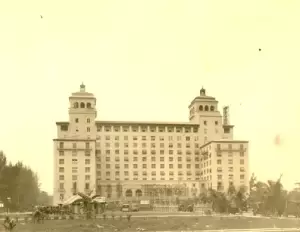1925 Hotel Fires
The 1925 Breakers Fire

After burning to the ground in 1903, The Breakers had quickly been rebuilt. On March 18, 1925, over 400 guests were registered, including the “unsinkable” Mollie Brown (Titanic survivor), actress Billie Burke (The Good Witch of the North in The Wizard of Oz), and Mrs. Edward F. Hutton (Marjorie Meriweather Post). A fire was discovered in Mrs. William Hale Thompson’s fourth-floor room that was believed to have been caused by defective wiring. Guests threw their jewels and furs from the windows, but most of it disappeared in the ashes or was picked up by looters. Shop owners salvaged what they could of oriental rugs, jewels valued in the millions, and expensive gowns. Chief Joseph Borman, who had helped build the hotel, arranged for local protection and the National Guard. The North Bridge (now Flagler Memorial Bridge) was closed to safeguard the belongings laid out on lawns. Although the bridge and ferry were wooden, they remained intact.
The West Palm Beach Fire Department summoned help from surrounding towns. The Miami Fire Department arrived in 90 minutes with a pumper truck. Four months later, the Fourth of July celebration would include a hose race between the two departments.
Years later witnesses described the fire, including Miriam Stowers, who watched the water boiling in the swimming pool as she related in a 1962 interview with the Historical Society of Palm Beach County: “And of course, everybody contributed clothes to get the people away from here, because their clothes were all destroyed, and the stores ran out.”
The Breakers Casino
The Breakers Casino bathhouse was replaced in 1921 at a cost of $75,000. Although the building was mostly Colonial to match the hotel, the pool area was Spanish with pink stucco. The casino featured 1,000 dressing rooms, a ten-foot-deep pool, diving tower, a spectators’ gallery, and Russian and Turkish baths.
Mary Markham, a hotel employee, recalled:
Everybody was ordered to pick up their valuables and get out as quick as possible. … We found rooms at [the] country club there in Palm Beach. But it was a dreadful sight to see that building burn down in a few hours. It housed many of the finest people in the country, but fire shows no discretion. Rich and poor all had to suffer.
Mary Markham
The Palm Beach Hotel Fire
As The Breakers burned for the second time in 1925, Palm Beach resident Stafford Beach watched from the ocean pier as embers floated up through the air, across the island, and landed on the 400-room Palm Beach Hotel. Its 160 guests, who had been watching The Breakers fire, barely reached their own rooms in time to save small articles; the frame building burned down completely.

The hotel’s owner, Sidney Maddock, lamented: “The dear old Palm Beach Hotel is a total loss. … I was there at the time and held the hose like the rest but it blazed in seven places at once way up on the roof. It’s history now.”
His parents, Henry and Jeanie Elizabeth Smith Maddock, of Staffordshire, England, had made their home at Duck’s Nest on North Lake Way in 1891, which remained in their family until 2019. Sidney Maddock had married Lucy Lacoste and in 1902 built the Palm Beach Hotel on Lake Worth. After it burned down, Maddock left Palm Beach and never returned. His son, Paul Lacoste Maddock, moved to Palm Beach in 1939 and married Ruth Marian Quigley Moffett, a descendant of Charles Carroll, the first signer of the Declaration of Independence.

On the site of the Palm Beach Hotel, Maurice Heckscher built the $7 million Alba Hotel. Named for his polo-playing friend the Spanish Duke of Alba, the 12-story hotel opened in February 1926 with 550 rooms. The first party for 1,000 was hosted by Mrs. Edward T. Stotesbury, Mrs. Paris Singer, and other notable socialites. By May, the hotel was bankrupt, although it reopened the following year. By 1929, it became part of the Ambassador Hotel chain. The next owner, Colonel Henry Doherty, changed the name to the Biltmore in 1934.


